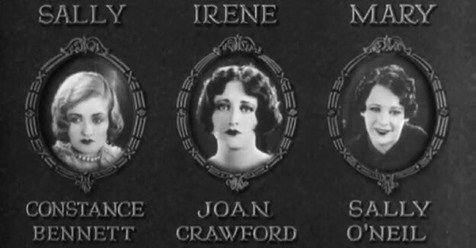
The Best of Everything
Encyclopedia Entry • Films Main
Sally, Irene, and Mary
1925

Critics' Reviews • Our Reviews • Movie Posters • Lobby Cards • Misc. Images
Click here to see photos from the film.
|
US release: 12/7/25 (premiere); 12/27/25 (general). Print survival status: The George Eastman Museum restored the film in 2018 with funding from the Louis B. Mayer Foundation, and premiered the restoration in 2019. From the Eastman website (where you can also view a 2-minute restoration trailer): Like so many films from the silent era, once talking pictures arrived, Sally, Irene and Mary went into the vault, with very little chance of being seen again. In the mid-1950’s the George Eastman Museum acquired from M.G.M. a 16mm print for the collection. In 2018 the Moving Image Department received a grant from the Louis B. Mayer Foundation to restore the film. But for this restoration to look the best, better elements were needed. Thanks to Warner Bros., we were able to borrow their 35mm Fine Grain Master. A fine grain master is a low contrast positive used to print duplicated negatives. This Fine Grain Master was struck off the 1925 original camera negative, which has since decomposed. To make the new negative and prints, we chose Cinema Arts, Inc. because they are known for their excellent work with black and white film. This film is now available in both 35mm and DCP. Cast: Constance Bennett, Joan Crawford (as "Irene"), Sally O'Neil, William Haines, Douglas Gilmore, Ray Howard, Aggie Herrin, Kate Price, Lillian Elliott, Henry Kolker, Sam DeGrasse, Mae Cooper. Credits: From the musical play by Eddie Dowling and Cyrus Woods. Adaptation: Edmund Goulding. Director: Edmund Goulding. Camera: John Arnold. Art Direction: Cedric Gibbons, Merrill Pye. Editing: Arthur Johns, Harold Young.
Plot Summary: Based on a musical comedy by Edward Dowling, this picture was Joan Crawford's breakthrough film. Her Charleston in this and other films would be defining moments for the 1920s. The worldly Sally (Constance Bennett), dreamy Irene (Crawford), and naïve Mary (Sally O'Neill) are friends who have risen up from New York's Lower East Side to become Broadway chorus girls. Sally's wealthy lover, Marcus Morton (Henry Kolker), falls for innocent Mary, and Irene, even though a decent man expresses his love for her, falls prey to one of Broadway's wolves. The man, however, has a change of heart, and sends Irene back home. She marries the right guy, but they are killed in an auto accident. Mary is shocked by Irene's death, and realizes that Morton symbolizes a world that does not really suit her. As a result, she settles down with Jimmy Dugan (William Haines), her childhood sweetheart, who has become a plumber. ~ Janiss Garza, All Movie Guide
Notes: • The original play by Eddie Dowling and Cyrus Woods opened on Broadway on 9/4/22 and ran for 313 performances. (IBDb entry) • The film was remade in 1938, starring Alice Faye, Joan Davis, and Marjorie Weaver. • Musical numbers accompanying the silent film at NYC's Capitol theater in 1925: Overture, "Capriccio Italien"; ballet, "Voices of Spring"; "Hawaiian Hours"; "The Slave Market," with singing and dancing; "A Peep into Siam."
George Eastman Museum page. (And Eastman blog page re Sally and its 2019 restoration premiere.) |
C. S. Sewell in Moving Picture World (December 19, 1925 -- Ed's note: The below, with its horrible punctuation, et al, is directly from the review, not my bad typing!)
Broadway Musical Comedy Success Made into a Pleasing Production by Edmund Goulding
Based on a musical comedy that enjoyed a long Broadway run, "Sally, Irene and Mary," adapted and directed by Edmund Goulding for the (sic) Metro-Goldwyn-Mayer offers light but pleasing entertainment.
The story deals with three members of a chorus of a Broadway show, Sally, the worldly-wise one, Irene, the dreamer, sought after by one of the Broadway wolves and also by a fine young chap, and Mary, an innocent little Irish girl who almost gets singed by the Bright lights. Sally's wealthy protector sees in Mary a new beauty and falls for her. Sally is dazzled and resents the attitude of her sweetheart a plumber. Irene succumbs to the lure of the Broadway wolf but in a moment of goodness he sends her home before it is too late and she marries the other fellow but they are killed when a train strikes the honeymoon auto. Sally's genuine grief and real love for her moneyed friend coupled with her unmasking of his real character, together with Irene's sudden death, so impress Mary that she says Broadway will never get her and forsaking this gilded street she returns to her plumber sweetheart.
With the exception of the railroad crossing wreck which provides a good punch, there is little dramatic action, the picture being more a study in contrasting characters of the three types of chorus girls. The story is carried along sympathetic lines and the interest sustained by situations that should prove entertaining to the majority, for instance, the Irish comedy scenes in Mary and Jimmie's homes with the spat between their mothers, backstage scenes of chorus girl life, attractive stage scenes, human interest touches in the love and watchful care of Irene's parents and the grief of the girls at her death, snappy dancing of the Charleston in a handsomely mounted stage scene and the final fade-out on the tenement roof under the new moon. The story does not move fast or develop any tense drama, but it is distinctly pleasing.
The
story has been given a high-class production and is portrayed by
a thoroughly capable cast. Both in type and in acting, Constance
Bennett, Joan Crawford and Sally O'Neill (sic) prove fine selections
for the title roles. Miss O'Neil as Mary, however, not only has
the most sympathetic and interesting role, but scores a big personal
success by her handling of this part. She is a newcomer but seems
destined for wide popularity on the strength of this performance.
The male roles are subordinate, Henry Kolker gives an exceedingly
fine portrayal of the only one of importance as the millionaire
Broadway roue who finally falls really in love with Mary after affairs
with many women.
Regina Cannon in the New York Evening Graphic (1925): [The film] is pretty cheap, tawdry, sentimental stuff poorly directed. The subtle touches (?) are put on with a shovel. But anyone who likes to see backstage life as it is sometimes lived may find some amusement in watching this tale unfold. Constance Bennett makes an alluring Sally and does the best work in the picture. Joan Crawford is a lovely Irene and Sally O'Neil as Mary is a pert youngster who is busy overacting every minute.
Mordaunt Hall in the New York Times (December 7, 1925): Edmund Goulding, who has contributed some sterling adaptations to the screen, including that of "Tol'able David," falls far short of his usual standard in the picturization of the musical comedy, "Sally, Irene and Mary," which he directed as well as adapted. This subject emerges from Hollywood as a species of "melodrama packed with trite ideas and appallingly obvious situations. It is a tawdry preachment concerned with the night life of gold-digging chorus giris, at the close of which the old-fashioned moral holds good.
The captions allude to the "wolves of Broadway." and the libertine of this picture, Marcus Morton, is designated the "leader of the pack." Judging from that which is thrown on the screen, Mr. Morton thinks of nothing else except stage beauties, and one opines that he looks in exceedingly good health considering the hours he keeps. Mr. Goulding reminds the spectators that a girl has been out all night, and he shows that she is still so full of life that she enthuses to her friends about the beautiful weather—the sun is pouring its rays through the window curtains. Mary, impersonated by Sally O'Neill, learns so much about the night life that she decides to refuse wealth and return to her Jimmy Dugan, a rather awkward young man who wears the same shirt day after day.
Irene, who is loved by a millionaire, is killed in an automobile wreck, which tragedy brings home to the girls the error of their ways, or at least, the fact that they are playing with fire.
There is quite an imposing sequence picturing a scene on the stage with the audience in the theatre. It is perhaps the best thing in this effort, and even this is spoiled at the end by a visitation of Irene's ghost.
No picture of this calibre would be quite complete without a moon. Here, through the clouds one perceives a new moon, which is followed by the frolicsome Mary and silk-shirted Jimmy embracing each other.
As contrasts there are Erte decorations and tenement house scenes. For suspense there is the telegraph operator writing a message as it comes over the wire, with long pauses between words. The senences, in the vernacular, are made to suit the occasion, and as this operator writes, the scene is switched to one of a girl and a man in a car racing with an express train, the girl leaning over and kissing the man, when a baby might have known that it was a risky thing to do.
Constance Bennett impersonates the more sophisticated of the trio of chorus girls. She is attractive and does as well as one can expect. Joan Crawford figures as the unfortunate Irene, and Sally O'Neill manifests a penchant for impudent comedy as Mary.
New York World (1925) Sally, Irene, and Mary, the eternal showgirls, the darlings of the musical comedy stage, have gone most successfully into the movies. From a sketchy plot, Edmund Goulding has wrought a picture amusing, light, so well done that it is a pity the contents mean so little. Without any call for histrionics, Constance Bennett, Joan Crawford, and Sally O'Neil in the title roles played with a polish to their performances that usually takes more years of experience to acquire than any of the three possess.
James R. Quirk in Photoplay (1925) One of the nicest pictures of backstage chorus girl life that it has been our lot to see. For a change, we see the tinseled creatures as they really are--hard-working, ambitious youngsters who go home to corned beef and cabbage, usually, instead of to night clubs and broiled lobster. The picture as a whole is very well cast, the title roles perfectly so...Joan Crawford, as Irene, the sentimental one, gives a good performance....
Variety (December 1925) Transplanted to the screen, this book for a musical show is rather trashy chorus-girl stuff. It's not a good picture. Dealing with Broadway’s back-stage angle, the script doesn’t ring true. Director Edmund Goulding has given the production one lavish stage setting for a full-stage Charleston number, but has fallen into the pitfall of having every member of the audience applaud as soon as the curtain starts to ascend. Sally is the ‘kept woman’ of the trio; Irene can’t make up her mind whether to choose a ‘chaser’ or a boy with honorable intentions, and Mary is the innocent miss who nearly loses Sally her de luxe flat when the latter’s money man takes a tumble in her favor. Constance Bennett gives the one genuine performance in the picture as Sally, and suffers because of an unsympathetic role. Joan Crawford makes a silly girl of Irene, with whom interest is lost when she falls for he of the evil intent, and it’s doubtful if there ever has been a chorus girl such as Sally O’Neill has been instructed to play in depicting Mary, fresh and too dizzy. |
If you've seen Sally, Irene, and Mary and would like to share your review here, please e-mail me. Include a star-rating (with 5 the best), as well as a photo of yourself or avatar to accompany your review and any of your favorite titles from the film.
|
Rating:
Sally, Irene, and Mary starts zippily with the hustle-bustle of a stage door (the Dainties Theatre on Broadway in this case). The title characters and their names are cleverly introduced upon their entrances at the theater: Sally (Constance Bennett) glides in grandly in a fur coat, receiving flowers and a telegram upon arrival. Irene (Joan) hurries along the busy street in her cloth coat, stopping to admire a little black boy's street-corner dance steps despite her lateness; her name is revealed stitched on her purse, which she drops, breaking a compact mirror (uh-oh...more to come!). Mary (Sally O'Neil) doesn't seem to worry about being late; she stops to banter with various shop-keepers, writing her name on the shop window of one owner. Once Mary's finally arrived at the theater, we also learn via another showgirl that she's a "little hick from the East-side...a pal of Irene's." Mary's a feisty little clown, making faces and cutting up, mocking ("blonde bozo!") the more ladylike Sally for using the supposedly genteel word "bicarbonate" (Joan's Irene tries to calm Mary down: "Don't be dumb. She's talkin' French!" Mary funnily reacts by further calling out to the refined, blonde Sally "you big Swede!")
The audience members and opening numbers further define the three girls and the conflicts that will ensue: We first meet Mary's working-class mother, beau Jimmy (William Haines), and Jimmy's mother all sitting together to cheer on their girl (and worry about her being so scantily clad). As Irene's spirited, spunky, hip group Charleston number begins, we're shown two men in the audience: "Paul --- the man who wanted Irene" (Douglas Gilmore, Joan's Apache lover in 1926's Paris and co-star in 1927's The Taxi Dancer), and "Jerry --- the boy who loved Irene" (Ray Howard, a complete non-entity in this film). Then, as Sally's much-more-elegant deco number begins, we see her older sugar-daddy Marcus Morton (Henry Kolker) slide, late, into his balcony seat, then proceed to ogle the new girl Mary rather than his own kept woman (AND to send his Sally a message telling her to bring the new girl to the after-party!).
So far, so... great! I was all primed to be amazed by this rarely seen silent film of Joan's---such a fast-paced opening, with such revealing character details. Unfortunately, for me at least, the rest of the film doesn't live up to its quite promising beginning. For a too-long time afterward, the film alternates between the goings-on at the decadent, beautiful Erte-designed apartment of Sally (paid for by Marcus Morton) and the dreary (both scenically and intelligently) tenement interactions of Jimmy and duelling frumpy peanut-crunching, beer-drinking mothers, who trade insults across the air shaft that separates their humble abodes.
Amid the debauchery of the Erte-apartment (where people constantly lounge and smoke, entertained by a black jazz band, and leave---or even arrive---only at daybreak), sugar-daddy Morton continually sadistically bullies his kept-woman Sally into inviting the raw, innocent Mary along on their dates---even insisting that Sally then withdraw from the outtings so he can be alone with his new "find." I don't think I've ever seen Constance Bennett in another movie, but here she's beautiful and subtle as she's constantly humiliated by Morton. (She also looks beautifully hurt lounging around and suffering in her also-Erte-designed gowns and robes.) To director Goulding's credit, it's not a catfight---Mary doesn't have anything to do with Sally's suffering: Mary is a clear-cut good egg, constantly putting Morton off, constantly asking about Sally, and constantly thinking about her plumber boyfriend Jimmy (even weirdly revelling in the smell of his hat: "Sweet essence of Jimmy!"). Mary only briefly considers Morton when she's trying to make Jimmy jealous.
After interminable scenes in the above vein, we finally get a title card near the last 15 minutes of the film: "But what of Irene?" Ha! I'd kind of forgotten about Joan/Irene, too! (Joan's "Irene" is second-billed in this film, but she's primarily an afterthought. Sally and Mary have the bulk of the scenes and emotional goings-on, with Irene only gratuitously dragged back in at the end to provide some sort of sick closing excitement.)
This is just sloppy filmmaking. Goulding had gotten caught up in the decadent Sally/Morton/Mary triangle, obviously not knowing what to do with the potentially equally decadent Paul/Irene/Jerry triangle also introduced in the opening scenes. Confused, Goulding elected to make the latter trio disappear until now: All of a sudden, Irene and Paul (you remember him: "the man who wanted Irene") are at his apartment in front of a fire, with him patting her on the head and sending her away because he apparently feels some compunction about not sleeping with a virgin. (Though, I'm assuming, based on the scrolling pianola lyrics---"A kiss in the dark was to him just a lark"---cleverly interspersed in their scene together, that they had at least kissed.) Immediately after leaving the smoldering Paul's apartment, Irene jumps in the car of Jerry, her forgotten beau who's been inexplicably parked outside.
And then comes some actually clever and exciting purely technical stuff for the relatively new medium of cinema in 1925: Shots of Irene and Jerry in his car racing next to a train in foggy weather (both close-up and long) are interspersed with close-up shots of a telegram operator typing out a telegram that Irene has sent to Mary at the theater: Irene has married Jerry "for spite." Cut to car, then back to typing that Irene will be "back in time for show tomorrow..." Cut to car, then typist: "This is more like a funeral than a wedding. Pray for me..." Cut to... CRASH! And the already broken mirror from Irene's compact landing, further cracked, next to the car wheel!
WOW! I almost bumped my review rating up from 2-1/2 to 3 stars for this! (And for the subsequent dark humor of the shot of the grammatically incorrect hand-painted sign in the showgirl dressing room that night, which the girls made upon thinking that Irene was just married and not DEAD: "Your finished Irene.")
So, yes, I again temporarily had good feelings about this film...which were immediately dispersed upon the showgirls' learning about Irene's death and then going onstage for their Charleston number once led by Irene. The formerly quite-spirited number, as seen at the start of the film, is now dampened by the girls' weeping in their grief as they try to dance. The weeping part is honest and touching, and might have made an interesting echo to the beginning Charleston number. BUT WAIT, THERE'S MORE... Look up, girls! There's the ghost of Irene dancing the Charleston in her usual spot onstage! This isn't presented as an internal thought/vision of the various showgirls. No, they actually see the Ghost of Irene and then proceed to both shriek in horror and literally topple over like dominos into the orchestra pit!
Good lord, Goulding! The director couldn't decide what he wanted to do here, and wasted the majority of the film on trite decadence/love triangles and/or trite tenement, lowest-common-denominator filler humor. Oh, I forgot to mention: The film ends with love-birds Mary and Jimmy in a moonlit embrace atop their tenement. Clunk.
As a side note: Goulding also directed Joan in 1926's Paris and 1932's Grand Hotel. And even with only these early films plus Sally, Joan later said that he was one of the four directors who had most influenced her work (the other three: Clarence Brown, George Cukor, and Mike Curtiz).
Another side note: While the film is officially listed at 58 mins, the full YouTube version that I watched was actually 1:15, or 75 mins.
Rating:
Cute
movie. JC plays Irene, a dancer. Constance Bennett, later of Topper
fame, is Sally. Sally O'Neil---whose Hollywood star shone brightly but
briefly---is Mary O'Brien. All are Broadway chorus girls, a natural role
for the erstwhile Lucille LeSueur, who's only a year or so removed from
that point in her life. The
movie starts off with clever vignettes that introduce you to the three
title characters and gives you a glimpse into their personalities. Sally
is a kept woman. Alas for Sally, her "keeper,” Morton, has eyes for
Mary. This largely defines the main storyline of the film. In the other,
Irene is courted by two men: a sophisticated older man, Paul, and a
younger naive gent, Jimmy. Not to be overlooked is JC's good pal, Billy
Haines, who plays Sally's boyfriend, Jimmy Dugan, and who disapproves of
her show business life and obviously is thus in conflict with Morton.
The mothers Dugan and O'Brien pop up from time to time in the movie for a
little comic relief. In
the end, Paul gives Irene the air, as the movie puts it in '20’s lingo,
and tells her to "stay as good as you are now.” This then drives her into the arms
of the young Jerry; revenge marriage?! They elope with tragic
consequences. Sally is dumped, but Mary goes back to Jimmy, thus leaving
behind the stage life. Lot going on in this 58-minute potboiler! Like
all of JC's earliest movies, it suffers from one fundamental flaw:
there is not enough Joan! To be honest, Constance Bennett and Sally
O'Neil have the meatiest roles. So, if you're here to observe our
budding superstar in her earliest Hollywood days, the glimpses of Joan
are relatively few. But what we see is fascinating. This is 2 years
before she was in The Unknown, a film, by her own admission, where she
learned to act rather than look good in front of the camera by
observing Lon Chaney. But, Crawford looks good! For those who have seen
only her later movies, it is hard to believe this is the same person. I enjoyed this movie, not only for its historical significance in the JC filmography, but also because it is a nice, short little story. Good way to pass an hour and a few minutes.
|
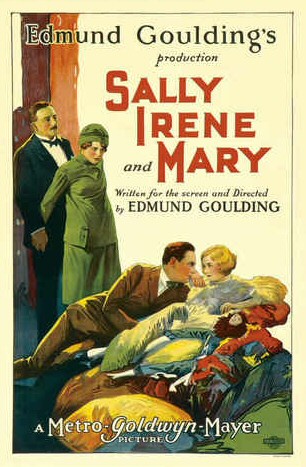
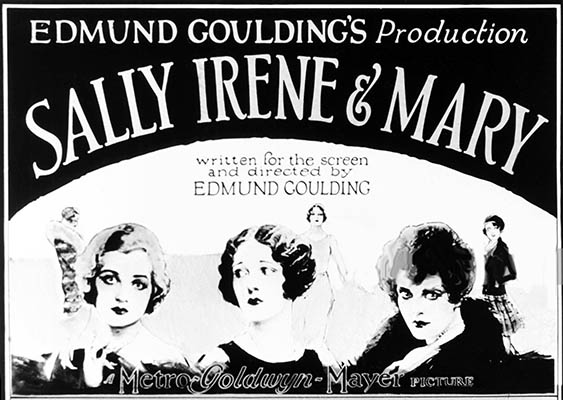
Above: US posters.
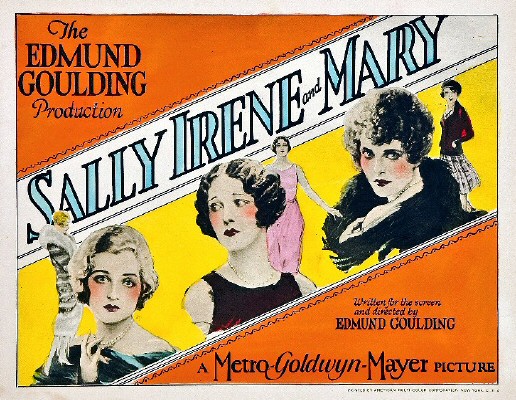
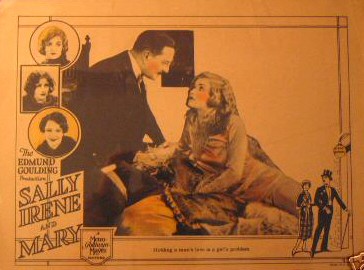
Above: US lobby cards.
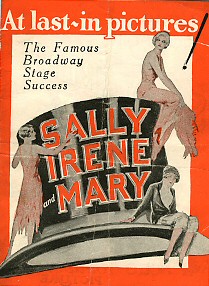
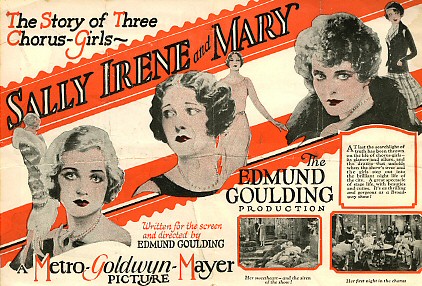

Above left: A US herald cover and centerfold. Above right: A slide exhibited at theaters.
Below left: A NYC newspaper ad. Below right: A US trade ad.
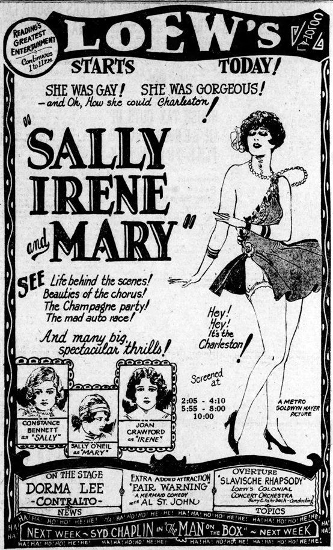
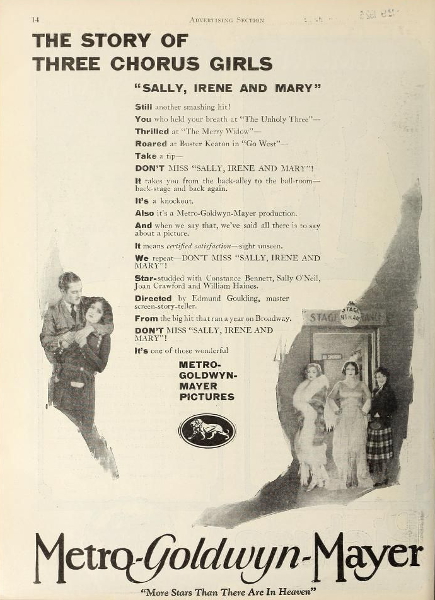
Below: A 2-page promo ad appearing in Film Daily, 1925.

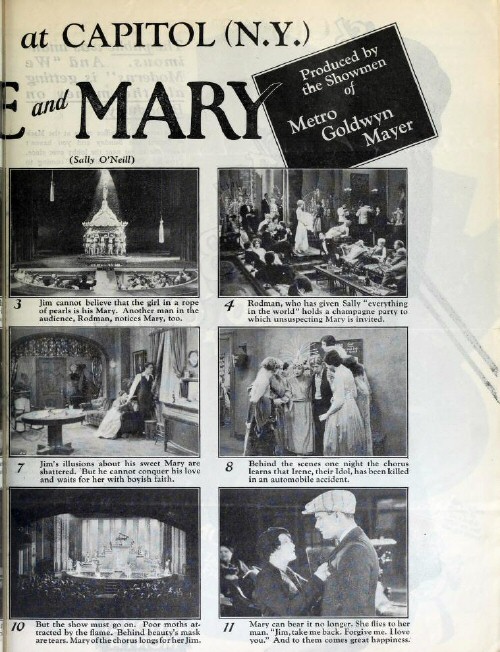
The Best of Everything